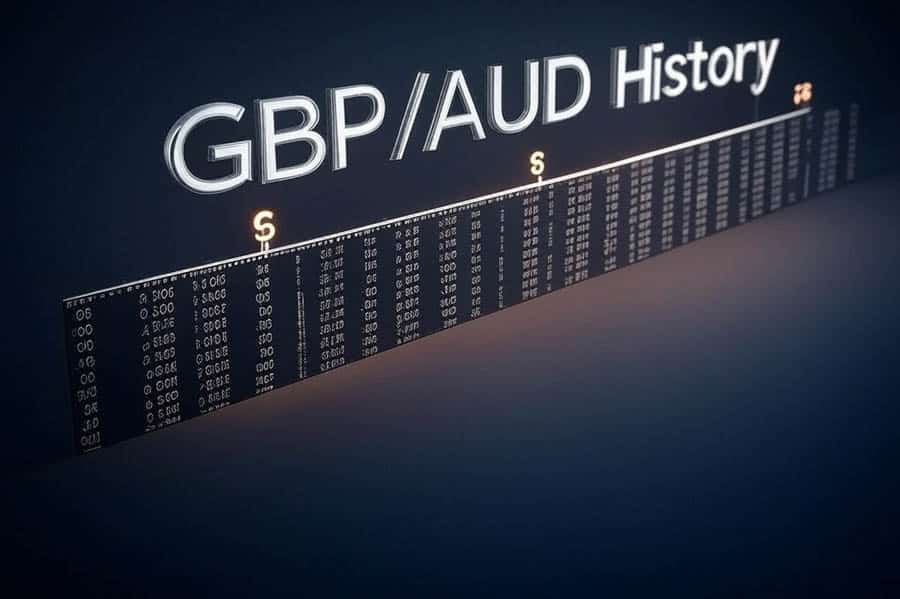Imagine tapping into a forex market where the British Pound meets the Australian Dollar, creating dynamic trading opportunities that can elevate your investment strategy. Understanding what is GBP AUD in forex is not just beneficial—it’s essential for traders aiming to diversify their portfolios and maximize profits. Whether you’re a novice eager to delve into forex trading or a seasoned investor looking to refine your strategies, mastering the GBP/AUD currency pair can open doors to significant financial gains. In this in-depth guide, we’ll explore every facet of the GBP/AUD pair, from its fundamental components to advanced trading strategies, ensuring you have the knowledge and tools to succeed. Additionally, we’ll highlight the importance of selecting a reliable forex broker to enhance your trading experience. Let’s embark on this journey to decode the GBP/AUD forex pair and transform your trading approach.

Understanding GBP AUD in Forex Trading

Grasping the essence of the GBP/AUD pair is crucial for making informed trading decisions. This section delves into the fundamental aspects of both currencies and how their interplay shapes the forex market.
Defining GBP/AUD in Forex
The GBP/AUD forex pair signifies the exchange rate between the British Pound Sterling (GBP) and the Australian Dollar (AUD). In forex trading, this pair indicates how many Australian Dollars are required to purchase one British Pound. For example, if the GBP/AUD exchange rate is 1.8500, it means that 1 GBP equals 1.85 AUD. This pair is particularly popular among traders who seek to capitalize on the economic ties and market dynamics between the UK and Australia.
The British Pound (GBP): A Pillar of Global Finance
The British Pound, represented by the symbol GBP, is one of the oldest and most traded currencies globally. As the official currency of the United Kingdom, the GBP plays a pivotal role in international finance and is a cornerstone in the forex market. The strength and stability of the GBP are influenced by various factors, including the UK’s economic performance, political stability, and monetary policies set by the Bank of England. Traders closely monitor indicators such as GDP growth, employment rates, and inflation to gauge the GBP’s potential movements against other currencies like the AUD.
The Australian Dollar (AUD): The Commodity Currency
The Australian Dollar, denoted as AUD, is the official currency of Australia and is classified as a commodity currency. This classification stems from Australia’s significant exports of natural resources and commodities, including iron ore, coal, and gold. The value of the AUD is intrinsically linked to global commodity prices and the performance of Australia’s economy. Additionally, the Reserve Bank of Australia’s monetary policies and economic indicators, such as GDP growth and employment data, play a crucial role in determining the AUD’s strength in the forex market.
The Dynamics of GBP/AUD Currency Trading
The GBP/AUD currency trading pair reflects the relative value of the British Pound against the Australian Dollar. Traders analyze this pair to exploit fluctuations driven by economic data releases, geopolitical events, and shifts in market sentiment. Understanding the intricate relationship between GBP and AUD is essential for predicting market movements and executing profitable trades. This pair is known for its volatility and responsiveness to global economic changes, making it a favorite among traders who thrive in dynamic market conditions.
Factors Influencing GBP AUD Exchange Rate

Several factors influence the GBP/AUD exchange rate, shaping the trading landscape and offering opportunities for savvy investors. This section explores the key determinants that impact this currency pair.
Economic Indicators from the UK and Australia
Economic indicators are fundamental in assessing the strength and stability of a currency. For the GBP/AUD pair, vital indicators from both the UK and Australia include:
- GDP Growth: Higher GDP growth rates in the UK or Australia can enhance the value of their respective currencies, making the GBP/AUD pair more attractive to traders.
- Employment Data: Employment rates and job creation figures influence investor confidence. Robust employment data typically strengthens the currency, while high unemployment can have the opposite effect.
- Inflation Rates: Controlled inflation supports currency value by maintaining purchasing power. Conversely, high inflation can erode currency value, leading to depreciation.
- Trade Balances: A trade surplus can boost a currency’s value as it indicates strong export performance, whereas a trade deficit may lead to currency depreciation.
Interest Rate Differentials: A Critical Component
Interest rate differentials between the Bank of England and the Reserve Bank of Australia significantly impact the GBP/AUD exchange rate. Higher interest rates in one country compared to the other attract foreign investment, increasing demand for that currency. Traders keenly watch central bank decisions and interest rate announcements to anticipate potential currency movements. For instance, if the Bank of England raises interest rates while the Reserve Bank of Australia maintains or lowers rates, the GBP may strengthen against the AUD, making the GBP/AUD pair more lucrative.
Political Events and Their Ripple Effects
Political stability and policy changes are potent factors influencing currency values. Events such as Brexit, general elections, or shifts in trade policies can introduce volatility into the GBP/AUD pair. Political uncertainty often leads to market volatility as investors react to new developments. For example, Brexit created significant uncertainty around the GBP, causing fluctuations as the UK navigated its exit from the European Union. Similarly, political stability in Australia can bolster the AUD, while instability may weaken it, directly affecting the GBP/AUD exchange rate.
The Role of Commodity Prices in AUD Valuation
As a commodity-exporting nation, Australia’s economy is heavily influenced by global commodity prices. The AUD is particularly sensitive to fluctuations in the prices of key exports like iron ore, coal, and gold. When commodity prices rise, Australia’s export revenues increase, strengthening the AUD. Conversely, a decline in commodity prices can lead to a weaker AUD. This relationship is crucial for traders of the GBP/AUD pair, as changes in commodity prices can directly impact the exchange rate, providing opportunities for strategic trades based on commodity market trends.
Read More: Cross Currency Pairs in forex
Trading GBP AUD: Strategies and Insights

Trading the GBP/AUD pair requires a nuanced understanding of market dynamics and the application of effective strategies. This section provides an overview of trading sessions, volatility characteristics, and commonly used strategies to enhance your trading performance.
Optimal Trading Sessions for GBP/AUD
The GBP/AUD forex pair experiences the highest liquidity during the overlapping trading hours of the London and Sydney sessions. This period typically occurs in the morning hours GMT, when traders in both regions are active, leading to increased trading volume and tighter spreads. High liquidity translates to better execution efficiency and more favorable trading conditions. By aligning your trading activities with these peak hours, you can take advantage of the heightened market activity and potentially capitalize on significant price movements.
Understanding Volatility in GBP/AUD Trading
The GBP/AUD pair is renowned for its moderate to high volatility, driven by economic releases, geopolitical events, and shifts in market sentiment. Volatility presents both opportunities and risks for traders. High volatility can lead to substantial price swings, offering the potential for significant profits. However, it also increases the risk of losses, making it essential for traders to implement robust risk management strategies. By understanding the volatility characteristics of the GBP/AUD pair, traders can better navigate price fluctuations and make informed trading decisions.
Effective Strategies for Trading GBP/AUD
Successful trading of the GBP/AUD pair involves employing a variety of strategies tailored to its unique characteristics. Common strategies include:
- Trend Following: This strategy involves identifying and trading in the direction of established trends. By using technical indicators like moving averages, traders can confirm the trend direction and enter positions accordingly.
- Range Trading: Range trading capitalizes on price movements within defined support and resistance levels. Traders identify these levels and execute buy or sell orders when the price approaches the boundaries of the range.
- Breakout Trading: Breakout trading involves entering trades when the price breaks through key support or resistance levels, signaling potential momentum. This strategy aims to capitalize on the ensuing price movement.
- Carry Trading: Carry trading takes advantage of interest rate differentials between GBP and AUD. By holding positions in currencies with higher interest rates, traders can earn the interest rate differential in addition to potential capital gains.
Implementing these strategies requires a comprehensive understanding of both technical and fundamental analysis. Traders should continuously refine their approaches based on market conditions and performance reviews to enhance their trading effectiveness.
Read More: Types of Currency Pairs in Forex
Historical Performance of GBP AUD Exchange Rate

Analyzing the historical performance of the GBP/AUD exchange rate provides valuable insights into its behavior and potential future movements. This section examines significant historical movements and trends over recent years.
Significant Historical Movements in GBP/AUD
The GBP/AUD pair has experienced notable fluctuations influenced by global events and economic developments. For instance, the Brexit referendum in 2016 caused significant volatility in the GBP/AUD exchange rate as uncertainty surrounding the UK’s exit from the European Union affected investor confidence in the British Pound. Additionally, fluctuations in global commodity prices have historically impacted the AUD, leading to corresponding movements in the GBP/AUD pair. Events such as changes in oil prices, trade agreements, and geopolitical tensions have also played pivotal roles in shaping the exchange rate dynamics.
Trends Analysis Over Recent Years
In recent years, the GBP/AUD pair has exhibited both upward and downward trends, reflecting the economic conditions in the UK and Australia. Analyzing these trends helps traders identify recurring patterns and potential turning points. For example, periods of economic growth in the UK, characterized by rising GDP and employment rates, have typically strengthened the GBP against the AUD. Conversely, economic challenges in Australia, such as declining commodity prices or slower GDP growth, have weakened the AUD, impacting the GBP/AUD exchange rate. By studying these historical trends, traders can better anticipate future movements and adjust their strategies accordingly.
Technical Analysis of GBP AUD
Technical analysis is a critical tool for traders looking to predict future price movements based on historical data. This section explores the common technical indicators and chart patterns applied to the GBP/AUD pair.
Key Technical Indicators for GBP AUD
Traders frequently use a variety of technical indicators to analyze the GBP/AUD pair and inform their trading decisions. Some of the most commonly used indicators include:
- Moving Averages: Moving averages smooth out price data to identify the direction of a trend. Simple Moving Averages (SMA) and Exponential Moving Averages (EMA) are popular choices for gauging trend direction and potential reversal points.
- Relative Strength Index (RSI): RSI measures the speed and change of price movements, helping traders identify overbought or oversold conditions. An RSI above 70 indicates overbought conditions, while an RSI below 30 suggests oversold conditions.
- Bollinger Bands: Bollinger Bands consist of a moving average and two standard deviation lines above and below it. They indicate volatility and potential price breakouts, helping traders identify entry and exit points.
- MACD (Moving Average Convergence Divergence): MACD is a momentum indicator that shows the relationship between two moving averages of a currency pair’s price. It helps traders identify changes in the strength, direction, momentum, and duration of a trend.
These indicators provide valuable insights into market trends, momentum, and potential reversal points, enabling traders to make data-driven decisions.
Common Chart Patterns in GBP AUD Trading
Chart patterns are visual representations of price movements that can signal potential market directions. In the GBP/AUD pair, traders often observe patterns such as:
- Head and Shoulders: This pattern indicates a potential trend reversal from bullish to bearish. It consists of three peaks, with the middle peak (head) being the highest.
- Double Tops and Bottoms: These patterns signal possible trend changes. A double top indicates a bearish reversal, while a double bottom suggests a bullish reversal.
- Triangles: Triangle patterns suggest consolidation phases before a breakout. Ascending, descending, and symmetrical triangles each have unique implications for future price movements.
- Flags and Pennants: These short-term continuation patterns indicate a brief consolidation before the current trend resumes. Flags are rectangular-shaped, while pennants are small symmetrical triangles.
Recognizing these chart patterns can provide traders with critical signals for entering or exiting trades, enhancing their ability to capitalize on market movements.
Read More: Forex Pairs with Least Correlation
Risks and Considerations in GBP AUD Trading
While trading the GBP/AUD pair offers numerous opportunities, it also comes with inherent risks. This section highlights the potential risks involved and the importance of implementing effective risk management strategies.
Potential Risks in Trading GBP AUD
Trading the GBP/AUD pair entails several risks that traders must be aware of:
- Market Volatility: The GBP/AUD pair is known for its volatility, which can lead to significant price swings. While volatility presents opportunities for profit, it also increases the risk of substantial losses.
- Leverage Risks: Forex trading often involves the use of leverage, which can amplify both profits and losses. High leverage increases exposure to market fluctuations, making it essential for traders to manage their positions carefully.
- Economic Uncertainty: Unpredictable economic events, such as unexpected changes in GDP growth or employment rates, can impact the GBP/AUD exchange rate unexpectedly.
- Political Instability: Geopolitical tensions or policy changes in the UK or Australia can create market uncertainty, leading to increased volatility and unpredictable exchange rate movements.
Importance of Risk Management Strategies
Effective risk management is paramount in forex trading to protect capital and ensure long-term success. Key risk management strategies include:
- Setting Stop-Loss Orders: Stop-loss orders limit potential losses by automatically closing a position when the price reaches a predetermined level.
- Diversifying Trades: Diversifying investments across different currency pairs and assets reduces exposure to any single market movement.
- Managing Leverage: Using appropriate leverage levels that align with your risk tolerance helps mitigate the risk of significant losses.
- Implementing Position Sizing: Calculating the appropriate size of each trade based on account size and risk tolerance ensures that no single trade can disproportionately impact your portfolio.
By incorporating these risk management strategies, traders can navigate the volatile forex market more effectively and safeguard their investments.
Pro Tips for Advanced Traders: Mastering GBP AUD Trading
Mastering the GBP/AUD Pair
For those looking to take their GBP/AUD trading to the next level, consider these advanced tips:
- Leverage Fundamental Analysis: Dive deeper into economic reports and geopolitical developments to anticipate market movements.
- Utilize Advanced Charting Tools: Incorporate multiple technical indicators and chart patterns to refine your trading strategy.
- Stay Informed: Continuously monitor global news and updates that can affect the GBP and AUD.
- Develop a Trading Plan: Outline your trading goals, strategies, and risk management rules to maintain consistency and discipline.
- Backtest Your Strategies: Use historical data to test the effectiveness of your trading strategies before applying them in live markets.
Implementing these advanced techniques can enhance your trading performance and increase your chances of success in the GBP/AUD market.
Opofinance Services: Your Trusted Partner in Forex Trading
When trading the GBP/AUD pair, having a reliable broker is essential. Opofinance stands out as a premier ASIC regulated broker, offering a suite of services tailored to meet the needs of both novice and experienced traders.
Why Choose Opofinance?
- ASIC Regulated: Ensuring your investments are secure and trustworthy.
- Social Trading Service: Connect with and learn from top traders in the community.
- Featured on MT5 Brokers List: Access advanced trading tools and platforms.
- Safe and Convenient Deposits and Withdrawals: Enjoy hassle-free transactions with multiple payment options.

Take control of your forex trading journey with Opofinance. Join us today and experience the difference!
Conclusion: Navigating the GBP/AUD Forex Pair with Confidence
Mastering what is GBP AUD in forex is a fundamental step for any trader aspiring to succeed in the dynamic forex market. By understanding the factors that influence the GBP/AUD exchange rate, implementing effective trading strategies, and managing risks diligently, you can navigate this currency pair with confidence and precision. The GBP/AUD pair offers unique opportunities driven by economic indicators, interest rate differentials, political events, and commodity price movements. Leveraging technical analysis and historical performance insights further enhances your ability to make informed trading decisions.
Choosing a reliable forex broker like Opofinance amplifies your trading potential by providing secure, innovative, and user-friendly services tailored to your needs. Whether you’re leveraging advanced trading tools, engaging in social trading, or utilizing safe deposit and withdrawal methods, Opofinance equips you with the resources to achieve your financial goals.
Remember, the key to successful trading lies in continuous learning, disciplined execution, and strategic planning. Equip yourself with the knowledge and strategies discussed in this guide to maximize your trading potential and achieve lasting success in the GBP/AUD market.
Key Takeaways
- GBP/AUD represents the exchange rate between the British Pound and the Australian Dollar, a dynamic currency pair in the forex market.
- Economic indicators, interest rate differentials, political events, and commodity prices are pivotal factors influencing the GBP/AUD exchange rate.
- Successful trading of GBP/AUD involves understanding optimal trading sessions, volatility characteristics, and employing effective strategies such as trend following and breakout trading.
- Technical analysis and chart patterns are essential tools for predicting market movements and making informed trading decisions.
- Risk management strategies, including setting stop-loss orders and managing leverage, are crucial to mitigate potential losses in the volatile forex market.
- Opofinance offers reliable services, including social trading and secure transaction methods, making it an excellent choice for GBP/AUD traders seeking a trusted broker.
How do changes in UK and Australian GDP affect the GBP/AUD exchange rate?
Changes in GDP growth rates in the UK and Australia significantly impact the GBP/AUD exchange rate. Higher GDP growth in either country typically strengthens its currency as it signals a robust economy, attracting foreign investment. For instance, if the UK’s GDP growth outpaces Australia’s, the GBP may appreciate against the AUD, leading to a higher GBP/AUD exchange rate. Conversely, if Australia’s GDP growth accelerates while the UK’s lags, the AUD could strengthen against the GBP, resulting in a lower GBP/AUD rate.
What impact do natural disasters in Australia have on the AUD and GBP/AUD trading?
Natural disasters in Australia can have a profound impact on the AUD and, consequently, the GBP/AUD exchange rate. Such events often disrupt economic activities, leading to a slowdown in production and exports, particularly in commodity sectors. The resulting economic uncertainty can weaken the AUD as investor confidence diminishes. A weaker AUD against the GBP means the GBP/AUD exchange rate may rise, offering trading opportunities for those anticipating these market reactions.
How can traders leverage central bank policies in GBP/AUD trading?
Traders can leverage central bank policies by closely monitoring announcements and policy decisions from the Bank of England and the Reserve Bank of Australia. Central banks influence interest rates and monetary policies, which directly affect currency values. For example, if the Bank of England signals an interest rate hike while the Reserve Bank of Australia maintains or lowers rates, the GBP is likely to strengthen against the AUD. Traders can position themselves ahead of such announcements by analyzing central bank communications and adjusting their strategies to capitalize on the expected currency movements.







